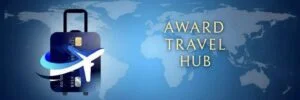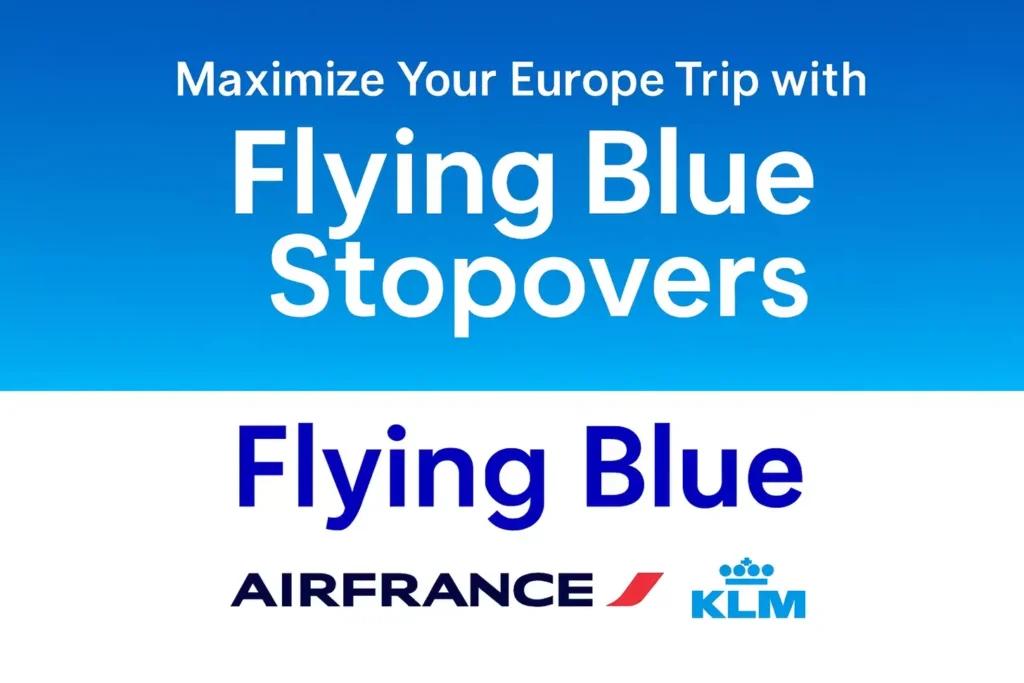Affiliate Disclosure: Award Travel Hub may earn a commission or referral bonus from some links on this site. These affiliate links help support our work and may influence the placement or promotion of certain products or services. However, our content is independently crafted to reflect honest opinions. Not all offers or products are included. There is no additional cost to users when they utilize our affiliate links.
73% of award shoppers miss free stopovers that could double the fun of a single ticket.
We show how to add a free stopover in Paris (CDG) or Amsterdam (AMS) when booking by phone with Flying Blue. The trick converts one-way saver awards into a practical two-city itinerary without extra miles.
Standard saver “from” rates set valid targets: economy from 25,000 miles, premium economy from 40,000 miles, and business from 60,000 miles one way. Expect roughly $100 in taxes in the economy and $200–$300 in business.
We’ll walk through a phone-booking example: book a U.S.–CDG saver award, ask the agent to add a multi-day stopover, then continue to another European city on the same ticket. Flexibility with dates and route choices unlocks the best value.
Key Takeaways
- Phone booking is required to add a free stopover at CDG or AMS.
- Saver rates start at 25k/40k/60k miles one way; dynamic pricing can be higher.
- Expect about $100 in taxes in the economy and $200–$300 in business each way.
- Search calendars and tools before transferring points to confirm availability.
- Families and points beginners benefit most from this simple award tactic.
Why Flying Blue Is the Smart Way to Book Europe Right Now
With the right routing and timing, a single saver award can yield two distinct city stays on a single ticket.
Saver “from” rates start at 25,000/40,000/60,000 miles one-way for economy, premium economy, and business on Air France and KLM. Those are baseline prices; dynamic pricing can raise the price on popular dates or last-minute travel.
Checking both the Air France and KLM sites matters. Each carrier can show different availability for the same flights and dates. Nonstop premium seats are often scarce, but adding a short connection inside the region can unlock lower mileage awards.

Policy perks allow you to connect nearly anywhere within the region, provided space is available. A phone agent can add a free stop in CDG or AMS that lasts up to 12 months. That allows us to turn one transatlantic award into a two-city itinerary without incurring extra miles.
- Compare miles + taxes vs. cash price to judge value.
- Promo rewards rotate monthly, so being flexible with dates boosts availability.
- Points from central U.S. banks transfer fast—so you can act when space appears.
Flying Blue Stopovers: Build 2-City Europe Trips for Less
Strategically routing through CDG or AMS can reveal award options that a nonstop search often hides. We rely on a simple process: search online, then call to purchase tickets.
Policy basics: the program allows a stopover in Paris or Amsterdam up to 12 months on award tickets, including one-way awards. These free stopovers usually don’t add miles, so totals often match the base transatlantic saver.

Phone booking required. Find candidate flights and collect flight numbers, then call customer service to add the stopover. Have backup segments ready if the agent needs alternatives.
Married-segment logic: Adding an onward connection after CDG or AMS can reveal Saver availability that a nonstop search may miss (for example, JFK–CDG–FCO). Search segment-by-segment to confirm cabins and timings before you call.
- Ideal routes: U.S. gateway → CDG/AMS → Rome, Barcelona, Prague, or Athens.
- Step-by-step flow: Find flights, verify availability, call to add a stopover, and then ticket with points.
- Checklist: align dates, cabin, connections, and have miles ready to transfer only after confirming space.
Plan Your Route: Hubs, Partners, and Within-Europe Connections
Selecting the right hub unlocks additional award routes and connections. We compare CDG and AMS in terms of flights, onward connections, and how agents handle stopovers.
Choosing AMS or CDG as your stopover hub and onward European cities
CDG often has more long-haul frequencies and direct links on Air France metal. AMS can offer smoother transfers and tighter connections on the Air France-KLM partner networks.
Shortlist cities with steady award availability, such as Rome, Barcelona, Prague, and Athens, to improve odds at saver levels.
When connections price the same vs. higher: manage expectations
Often, an intra-leg adds no extra miles when there is space available. However, dynamic pricing can increase the total cost on busy dates.
Search for alternative dates and routing options to ensure the connecting flight prices align with saver award pricing.
Repositioning to a promo city in the U.S. to cut mileage costs
Repositioning to a promo gateway (JFK, BOS, LAX) can lower miles on the long-haul segment. An overnight buffer reduces misconnect risk.
| Hub | Strengths | Best onward cities |
|---|---|---|
| CDG | More transatlantic flights, many long-haul options | Rome, Madrid, Athens |
| AMS | Smoother connections, strong regional links | Barcelona, Prague, Berlin |
| Tips | Use partners and single-ticket segments to protect baggage | Record backups before you call to ticket |
Find Award Space and Low Prices with the Right Tools
Start with a sweep of nonstop availability, then confirm pricing directly on the airline site.
Use SeatSpy for nonstop scans, then verify on Air France or KLM
We begin with a fast scan on SeatSpy to surface low-mileage dates and nonstop flights. That tool shows which days return the lowest flying blue rates.
Always verify the results on the airline website. Log in, set passenger counts, and filter award searches so the site returns accurate totals and confirmed availability.
Force a monthly calendar view on Air France to spot the cheapest dates
On Air France, leave dates blank in “Book with Miles” to force a monthly calendar view. The grid highlights the lowest “from” price days quickly.
This trick helps us zero in on off-peak dates when saver space in economy and premium cabins is likelier to appear.
Saver vs. Promo Rewards: identifying the lowest “from” rates
Compare Saver and Promo results in the calendar. Confirm the fare class, cabin, and total miles before moving any points.
“Always confirm space on the carrier site before transferring miles — transfers can be irreversible.”
- Scan nonstops first to lock a baseline number of miles.
- Layer intra-region segments on the site to see how adding a connecting flight affects pricing.
- If an added leg pushes the award past its value, consider buying that segment with cash and protecting yourself from taxes with a strong travel credit card.
Example workflow: Find a low-mileage JFK–CDG date on SeatSpy, confirm JFK–CDG and CDG–Rome availability on the airline’s site in the same cabin, then verify the total miles and taxes before transferring points.
Leverage Flying Blue Promo Rewards for Big Savings
Promo awards are published monthly and can shave significant miles off transatlantic tickets. We monitor the grid at the start of each month and secure deals before the month ends.
What promo rewards are and where to find current routes
Promo rewards are time-limited, discounted award fares shown on the program site. They list eligible routes and the reduced price for a set travel window.
Typical rates by cabin and how booking windows work
Common “from” rates: ~18,750 miles in economy, 30,000 in premium economy, and 45,000 in business one-way. Grids appear at the start of each month; you must book by the end of the month. Travel windows run for the coming months, so choose your dates early.
| Cabin | Typical Promo From | Notes |
|---|---|---|
| Economy | 18,750 miles | Widest availability; best baseline value |
| Premium Economy | 30,000 miles | Good for more extended comfort at a moderate cost |
| Business | 45,000 miles | High value on off-peak dates |
- Example: Select a listed U.S. city at 18,750 miles, then add a within-Europe continuation if pricing remains the same.
- Fee: changes/cancellations often cost about €70—factor that into plans.
- Availability can change quickly; check both carrier sites and be prepared with alternative routes.
- Stopovers are allowed but must be booked by phone; prepare segments before you call.
Points, Transfers, and Bonuses: Funding Your Award
Start by confirming award space, then fund only what you need. We maintain a concise checklist to prevent unnecessary transfers and to respond promptly when seats become available.
Where to transfer from and how fast it posts
Transfer partners, including American Express, Chase, Citi, Capital One, Bilt, and Wells Fargo, move at a near-instant 1:1 rate in most tests.
Marriott transfers at a 3:1 ratio with a 5,000-mile bonus per 60,000 points and can take approximately three days. That delay matters when space is scarce.
Bonus timing and a simple playbook
Watch for transfer bonuses from American Express and Capital One; they can reduce effective miles by 15–30% or more. When a bonus appears, move only the extra points you need.
- Confirm the award price and schedule first, then initiate the transfer.
- Maintain a small program balance to allow agents to ticket quickly, but avoid large idle balances due to the risk of dynamic pricing.
- Split points between two banks to hit exact miles and avoid over‑transferring.
- Charge taxes and fees to a travel credit card to earn benefits and purchase protection.
Value note: Pairing a transfer bonus with a Promo Reward can dramatically improve cents‑per‑mile returns. Always verify availability on the airline’s site before transferring points — transfers are usually irreversible.
Pricing Reality: Taxes, Fees, Changes, and Family Discounts
Taxes and service charges are the hidden costs that can significantly impact the value of an award on any itinerary.
Plan for roughly $100 in taxes each way in economy and about $200–$300 each way in business on transatlantic award bookings. These taxes and fees affect the total cost even when the miles cover the fare.
Promo award change/cancel fee and risk control
Promo Award changes typically incur a fee of approximately €70. To minimize that fee, lock availability first, then transfer just the points you need.
We recommend holding itinerary details and preparing backup segments before the call. Phone booking for a stopover adds time—have flight numbers ready.
Family discounts and practical tips
Children ages 2–11 get a 25% discount on award tickets when traveling with an adult. This usually does not combine with Promo Rewards, so please check the price and availability per passenger before transferring points.
| Item | Typical amount | How to manage |
|---|---|---|
| Economy taxes | $100 each way | Verify on the carrier site; transfer points after confirming |
| Business taxes | $200–$300 each way | Use a premium card to pay fees for protection |
| Promo change/cancel fee | ~€70 | Lock availability, choose flexible dates, transfer minimal points |
“Confirm final taxes/fees and passenger pricing before you move points.”
- Limit exposure: transfer only after final confirmation.
- Consider buying a short intra-region flight with cash if adding it increases the award price.
- Pick reasonable connection times when adding a stopover to avoid rebooking costs.
Conclusion
To wrap up, a straightforward workflow and a few tools turn routine award searches into high-value itineraries. Use the Flying Blue phone option to add a free stop and convert one ticket into two city stays without extra miles.
Verify space on the website, confirm exact flights, then transfer points and call to ticket. Check monthly promotional lists and watch for a transfer bonus from partners like American Express, Chase, Citi, Bilt, Wells Fargo, or Capital One.
Compare the total price, including fees and taxes, and pay with a strong travel credit card. Stay flexible on dates and routes. With this approach, we unlock more value and better options from the Air France KLM program.



